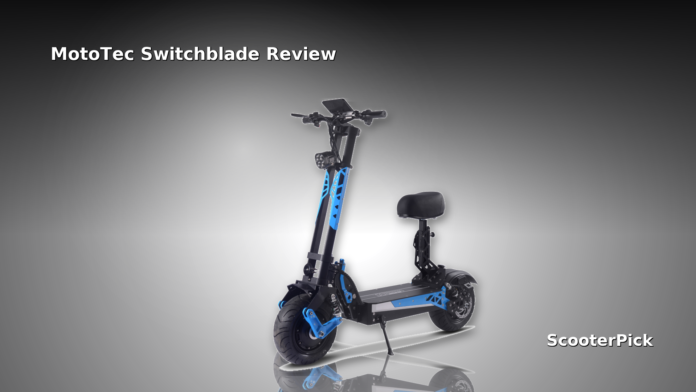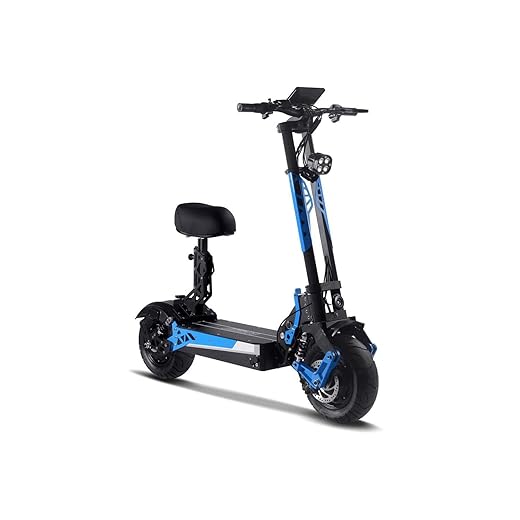Key Takeaways
- The MotoTec Switchblade offers a powerful dual-motor performance, reaching speeds up to 50 mph while supporting riders up to 330 lb.
- It features a sturdy aluminum frame, hydraulic disc brakes, and a comfortable removable seat, making it ideal for long rides.
- The battery provides a range of 20-37 miles, depending on factors like weight and terrain, with a charging time of 6-8 hours.
- Despite its strengths in performance and stability, the scooter is heavy at 154 lb, making it less suitable for carrying or tight paths.
- Overall, the MotoTec Switchblade Review highlights a reliable road cruiser that emphasizes speed and comfort over portability.
The MotoTec Switchblade is a big, dual-motor scooter built for speed and stability. This MotoTec Switchblade review covers how it feels on real roads, what it nails, and where it asks for trade-offs. If you want a fast, heavy scooter for paved routes and long straight shots, MotoTec Switchblade should sit on your shortlist.
Key Specifications
| Block | Details |
|---|---|
| General | Model: MotoTec Switchblade 60V 4000W • Form factor: sit-or-stand, foldable frame • Intended use: paved roads • Recommended age: 13+ • Max rider weight: 330 lb (150 kg) |
| Performance & Power | Motors: dual brushless hub, total 4000 W • Top speed: up to 50 mph (80 km/h) • Drive modes: Standard, Economy Mode button • Throttle: twist |
| Charging & Electrical | Battery: 60V 28Ah lithium-ion • Charge time: 6–8 hours • Display: LCD with speed, trip, odometer, battery, light indicator |
| Build & Dimensions | Frame: aluminum alloy • Deck: aluminum alloy • Tires: 130/50-8 street • Unfolded size: 57 × 25 × 51 in (145 × 64 × 130 cm) • Folded size: not specified • Wheelbase: 43.3 in (110 cm) • Seat height: 32 in (81 cm) • Ground clearance: 7 in (18 cm) • Scooter weight: 154 lb (70 kg) |
| Safety & Control | Brakes: front and rear hydraulic disc • Lighting: front and rear LED |
| Features & Extras | Folding latch • Removable seat • Economy Mode button • LCD cockpit • Fender set • Keyed ignition |
| Warranty & Compliance | Warranty: 60-day parts replacement • Compliance: manufacturer-stated general product safety, 13+ use |
Design & Build Quality
At first glance, the Switchblade looks closer to a compact moped than a slim city scooter, and that’s on purpose. The aluminum frame and deck feel stout, and the scooter sits high on wide 130/50-8 street tires. Because of that stance, it feels calm at speed, and the long wheelbase keeps the steering steady on straight pavement. The removable seat has dense padding, so longer rides feel less tiring.
Once you roll it out, the weight hits you. At 154 lb, it isn’t a carry item, and it feels planted the second you twist the throttle. Then the suspension shows what it can do. Dual shocks up front and dual shocks in the rear smooth small bumps, so the chassis doesn’t pitch or bob in normal street use. You still feel broken asphalt, but the edge softens, and tire contact stays consistent. For night rides, the LED headlight sits high and throws a useful beam, and the rear light marks your tail clearly.
Fit and finish look tidy for this class. The deck surface gives good grip with wet shoes, and the fenders hold their line without rattles. Cable routing around the bar and stem stays neat, so controls sweep cleanly through a full turn. Paint resists scuffs from daily parking, and the latch feels solid when you reef on it.
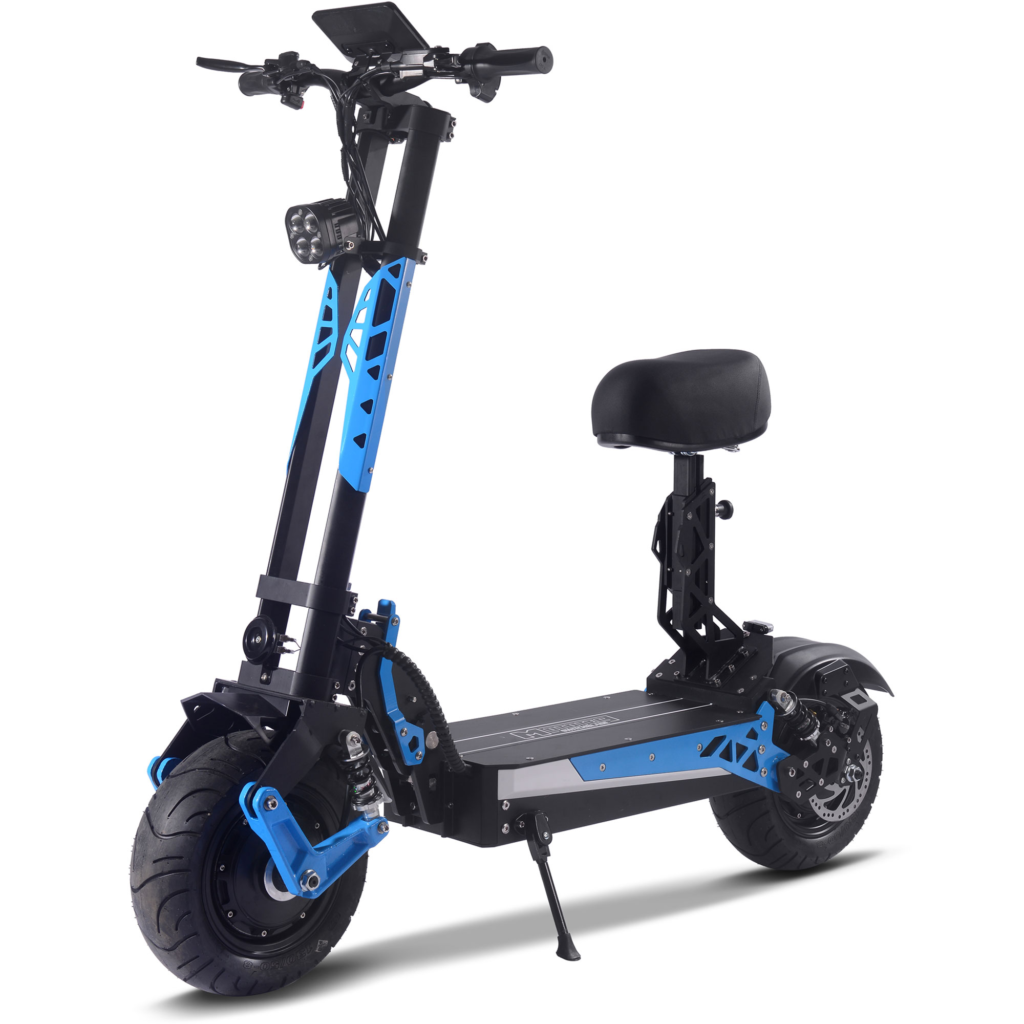
Motor, Power & Acceleration
The Switchblade runs two hub motors with a combined 4000 W rating, and it shows. Off the line, it pulls hard, and the mid-range shove keeps rolling even on mild grades. With a twist throttle, power delivery feels smooth, and low-speed control is easy in parking lots. The stated top speed is 50 mph, so open roads and clear sight lines suit it best. On moderate hills around 7–8%, it holds pace better than similar single-motor scooters. For range days, the Economy Mode button takes the sting out of the throttle and stretches miles.
Road surface still matters. On clean, dry tarmac, grip feels steady, and turn-in stays predictable. By contrast, loose gravel cuts traction fast, so back off before you roll into it. As speeds climb, the long wheelbase cuts twitch, and the scooter tracks straight without drama. Heavy riders near the weight limit still get honest pull on short climbs, which is nice if your route stacks a few.
Throttle mapping feels friendly. The first quarter turn gives smooth creep control for tight spots. Past half turn, the push ramps up, and the scooter builds speed to a relaxed cruise. The very top end needs space, so pick routes that match what the motors want to do.
Battery, Range & Efficiency
A 60V, 28Ah lithium pack sits under the deck and feeds both motors. Claimed range lands between 20 and 37 miles, which is a wide window on purpose. Rider weight, cruise speed, hills, wind, and the number of stops all move the needle. Ride steady at 20–25 mph on flat ground and use Economy Mode, and you’ll live near the high side. Rip hard sprints or climb long grades, and you’ll see the low side.
Charging is simple. Plan for 6–8 hours from low to full, so overnight works well. Plug in after you park, then let the charger finish. Unplug once full. Store the scooter at room temperature if you can. Cold weather knocks down output, so plan a shorter loop in winter.
Managing range is mostly habit. Reset trip at the start. Watch miles when the battery gauge hits halfway. Turn back with a cushion. Then keep your tires in the printed PSI range. Right pressure steadies draw and keeps steering feel consistent.
Ride Quality, Handling & Comfort
The Switchblade shines on open roads and longer runs. Because the wheelbase is long, the chassis stays calm, and the dual shocks take the sting out of sharp hits better than basic spring forks. Steering lightens once you’re rolling, and the bar height works for seated and standing riding. The seat sits at 32 inches, which suits medium and tall riders. Shorter riders can stand or perch forward at stops to keep a toe down.
The wide street tires track clean lines on smooth asphalt. Even so, deep ruts can pull the front, so keep both hands firm near construction zones. At 30–35 mph, the scooter feels planted, and wind buffeting is the main thing you notice. On coarse chip seal, the deck passes some buzz to your feet, yet the padded seat trims the fatigue. Tire pressure matters here. Run it too low and the steering goes dull. Run it too high and cracks feel loud.
The deck gives room for a natural staggered stance. Your rear foot sits square, and your front foot points a bit forward. That posture loosens your hips for bumps and cuts arm strain on longer days. The seat padding keeps its shape, and the height gives a clear view over car roofs in traffic.
Braking & Safety Features
Front and rear hydraulic discs bring strong, predictable stops. Lever feel stays firm, and the bite point is easy to read. On clean, dry pavement, you’ll set most of your braking up front, then add rear for balance. In the wet, brake earlier and softer, since paint, leaves, and metal plates lower grip.
Lights matter more on fast scooters. The LED headlight helps you pick out seams and pothole edges at speed, and the tail light makes your presence clear. The LCD screen puts speed and battery where you can glance without hunting. The deck is wide, so your feet stay planted. Fenders help with spray on damp days.
Do a quick setup check before your first ride. Spin each wheel and squeeze the levers to feel for drag. Then bed pads in with a few gentle stops. After that, lever feel should stay consistent if your rotors remain true and pads wear evenly.
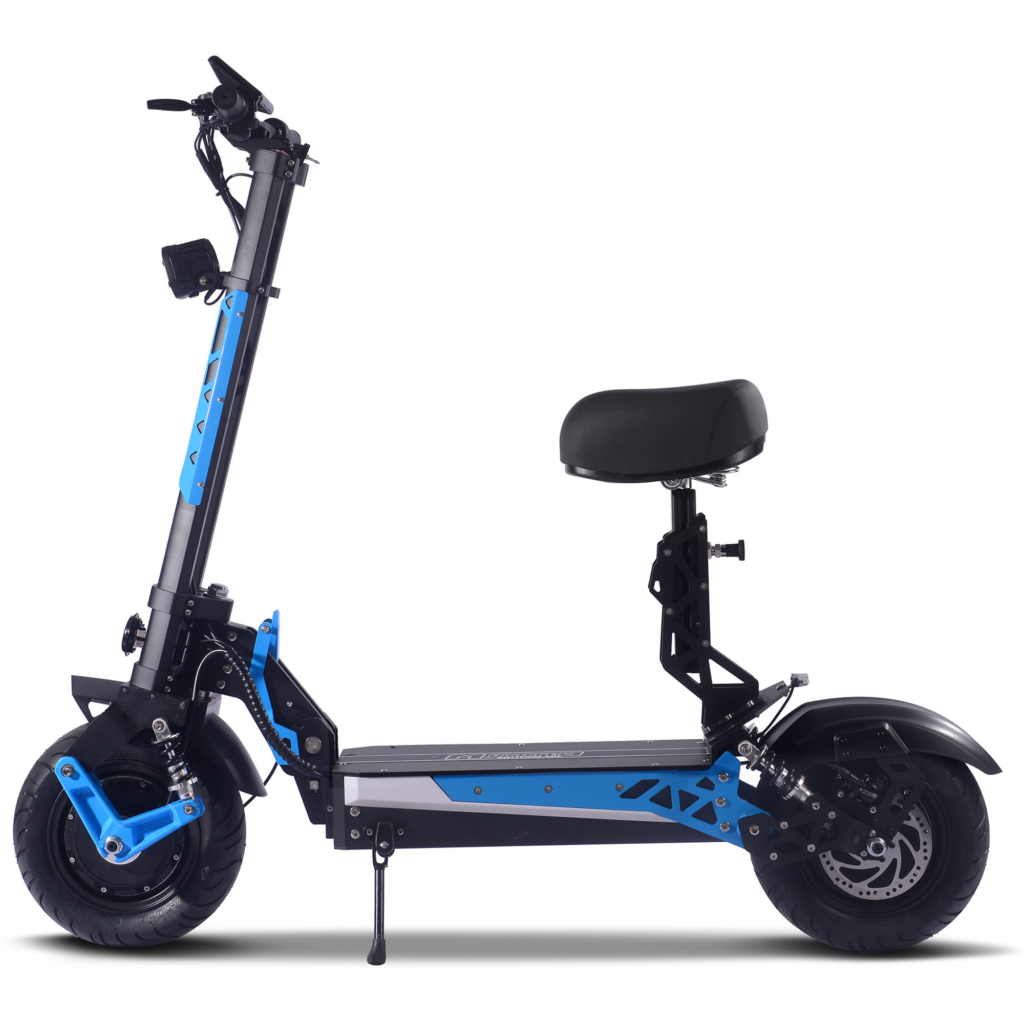
Portability & Daily Usability
This scooter isn’t a shoulder carry. At 154 lb, you want a ramp or ground-level storage. The folded size isn’t listed, and even folded it still eats space. If you live in a walk-up, plan to park at street level or in a garage. For transport, a hitch rack or van works, and two people make loading simple.
Day to day, the Switchblade fits riders with a driveway or a secure storage spot. The key ignition adds one small step against quick grabs, and the weight helps when parked. For short errands, the seat reduces fatigue in stop-and-go. For mixed rides, use Economy Mode in slow areas and save full power for open roads. The twist throttle gives fine control in tight spaces, so you can creep through parking lines without jerks.
If your routine involves stairs or long hallway pushes, this model will fight you. A folding dolly or a small threshold ramp helps with one-step entries. Keep a towel near your charge spot, then wipe dirt before you roll inside.
Features, App & Extras
The control layout stays simple. The LCD shows speed, trip, odometer, battery level, and a light icon. An Economy Mode button lowers draw for longer rides. The frame folds. The seat comes off if you prefer to stand. Lights are LED front and rear. There’s no phone app listed, and cruise control isn’t called out here. On long, flat stretches, you’ll hold the throttle.
The keyed ignition brings a bit of peace of mind in busy lots. That said, bring a stout lock and tie the frame to something that won’t move. In crowded spots, park within sight if you can.
Charging Experience & Maintenance
Plan on 6–8 hours for a full charge from near empty. Plug in after rides, give the pack time to top-balance, and keep the charge port cap clean. Don’t spray the scooter with a hose or pressure washer. Wipe it down with a damp cloth, then dry it.
Hardware checks keep the ride quiet. Every few weeks, check stem, bar, and axle bolts. A small torque wrench is handy, and a dot of medium threadlocker on high-stress fasteners helps tame rattles. Watch brake pad thickness and rotor condition, then swap pads when lever throw grows long. Keep tire pressure in the printed range. Correct pressure protects range and cuts pinch risk.
There’s no chain or belt here, so drivetrain upkeep is easy. Focus on the brakes, tires, suspension bushings, and the folding joint. That list fits in a quick weekend routine.
Hill Climbing & Heat Management
On moderate hills near 7–8%, the twin motors keep a steady pace. On longer climbs, speed will drop as grade stacks up, so pick a lane that lets you hold momentum. If your route chains hills back to back, take a short cooldown at the top, then roll easy for a minute. That habit helps battery and brakes.
Hot days add heat to everything. You’ll feel warmth in the deck and see a bit of voltage sag on the battery gauge during hard pulls. Pace the ride with easy sections between sprints. Finish with a light cruise so parts cool with airflow.
Ride Modes & Control Strategy
Standard mode gives full punch and suits open roads or short climbs. Economy Mode tames the throttle and caps output for neighborhoods, school zones, and days when you want more miles. The twist throttle rewards a relaxed grip. Keep your elbows bent so your arms soak bumps instead of your shoulders.
Group rides need a few ground rules. Leave space, call stops, and hold a lane. The Switchblade’s launch can gap friends at green lights, so roll off and let them close in. Smooth pacing beats sprint-and-brake cycles, and it saves range too.
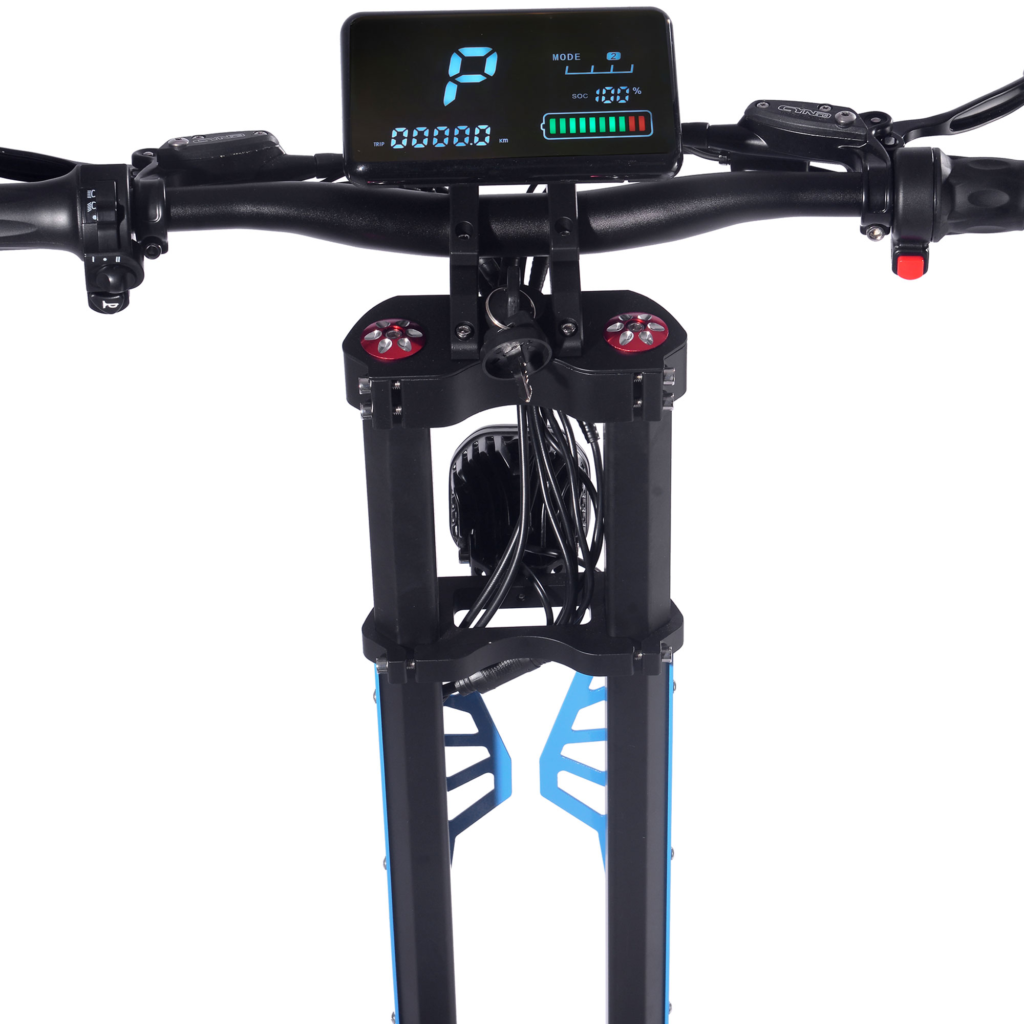
Tires, Pressure & Handling Notes
The 130/50-8 street tires carry a wide contact patch. They track true on clean asphalt and feel best with fresh tread. New tires can feel slick at first, so build speed step by step. Check pressure cold before rides. Small PSI changes make big steering changes on small wheels.
Paint stripes and metal plates ask for care. Reduce lean and brake sooner. On patchy roads, scan ahead, pick a clean line, and avoid sharp inputs. Under hard braking, shift weight a touch rearward to keep the back wheel planted.
Ergonomics, Deck Space & Controls
The deck has plenty of space for a normal staggered stance. The bars are wide enough for leverage without feeling bus-wide. The twist throttle gives smooth control over small bumps, and the levers sit where your fingers want them. Mirror mounts aren’t stock, so add bar-end mirrors if you like rear checks without shoulder turns.
For longer runs, the seat height supports an upright back and relaxed shoulders. On short hops, standing gives better shock control and extra height in traffic. The cockpit keeps key info high on the screen, so quick glances tell you what you need without fishing.
Water Use & Care
There’s no listed water rating here. Treat it as splash-tolerant, not swim-ready. Ride around deep puddles, slow down in heavy rain, and dry the scooter after wet sessions. Keep the charge port shut and angled down when parked. After damp rides, roll it into a dry space, then wipe the deck, joints, and the brake area.
A light lube on the folding latch and pivots helps cut squeaks. Keep lubricants off the rotors and pads. If brakes squeal after rain, clean the rotors with isopropyl alcohol, scuff the pads lightly, then bed them in again.
Who the MotoTec Switchblade Is For
Pick the Switchblade if you want a sit-or-stand platform with real highway-adjacent speed on private roads or open routes. Heavy riders up to 330 lb benefit from the twin motors and long wheelbase. Suburban riders with garages or ground-floor storage get the most out of it. City riders who climb moderate hills or carry a little gear will like the seated option.
Skip it if you need a light last-mile scooter or you deal with stairs often. If you prefer a smaller city runabout, the MotoTec Metro fits that role well. Skip it if your daily ride snakes through tight paths or cramped elevators. The size and weight don’t love frequent lifts.
Features, App & Extras (Quick Checklist)
- LCD with speed, trip, odometer, battery
- LED headlight and tail light
- Economy Mode button
- Folding frame and removable seat
- Keyed ignition
- No listed cruise control
- No phone app listed
Charging Experience & Maintenance (Quick Checklist)
- 6–8 hours from low to full
- Keep port cap clean
- No pressure washing
- Regular torque checks on stem, bar, axles
- Watch pad wear and rotor true
- Set tire pressure cold within printed range
Value for Money & Verdict: MotoTec Switchblade review
MotoTec built the Switchblade for riders who want strong power, a calm chassis, and a seated option in one package. The scooter trades easy carry and tight-path agility for speed, comfort, and a planted feel. If your routes match its strengths, the Switchblade delivers a quick, low-effort ride that feels tough and composed. It’s a road cruiser first and a stair-heavy commuter last. If you park on ground level and ride longer stretches, the experience pays off in low fatigue and steady control.
Pros & Cons
Pros
- Strong dual-motor pull with quick launches
- Long, stable wheelbase inspires confidence at speed
- Hydraulic discs with steady lever feel
- Clear LCD with speed, trip, and battery
- Removable seat helps on long rides
- Economy Mode stretches miles on slow days
- Bright LED headlight and tail light
- High rider weight rating at 330 lb (150 kg)
Cons
- Very heavy at 154 lb (70 kg)
- Large footprint, and folded size isn’t listed
- No listed cruise control or phone app
- Street tires dislike loose gravel
- Short 60-day parts warranty
- Not great for walk-ups or frequent lifts
- Water rating not stated
Price
FAQs
Is the MotoTec Switchblade street-legal?
Rules change by area, so check local speed limits, lanes, and lighting rules before you ride.
How fast does it go, and is it stable at speed?
The listed top speed is up to 50 mph, and the long wheelbase helps stability on smooth roads.
How long does a charge take?
Plan on about 6–8 hours from low to full, then unplug.
What range should I expect?
Most riders see 20–37 miles, depending on speed, weight, hills, and stops.
Does it have cruise control or an app?
No cruise control is listed, and there’s no phone app here.
Where can I find the MotoTec Switchblade review highlights fast?
Jump to the Value for Money & Verdict: MotoTec Switchblade review section for the short take.


